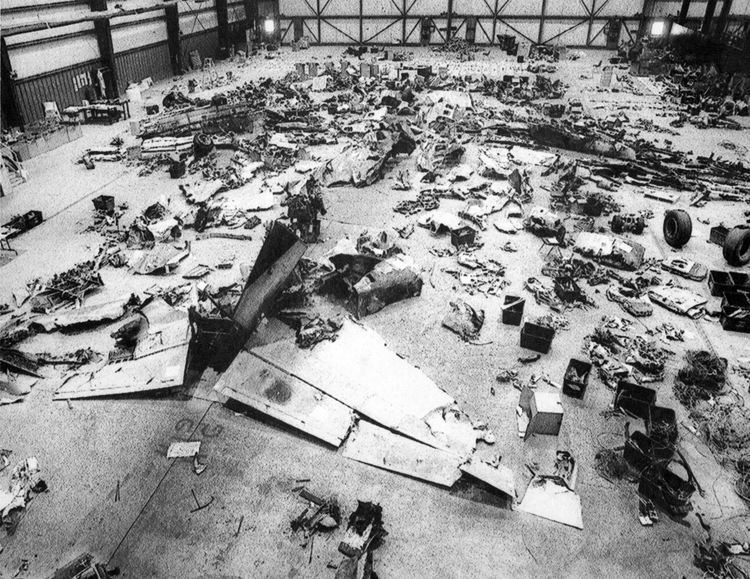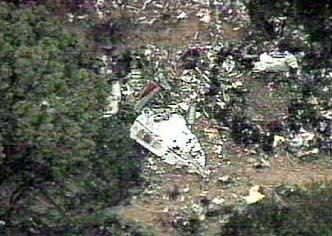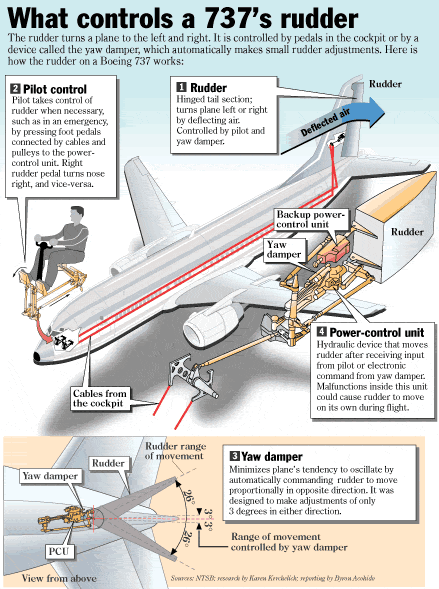Crew 5 Operator US Airways Survivor 0 | Passengers 127 Survivors 0 Date 8 September 1994 Fatalities 132 (all) Passenger count 127 | |
 | ||
Destination Palm Beach International Airport Similar United Airlines Flight 585, Eastwind Airlines Flight 517, 1986 Cerritos mid‑air co, Atlantic Southeast Airlines Fl, Philippine Airlines Flight 434 | ||
Usair flight 427 accident animation
USAir Flight 427 was a scheduled flight from Chicago's O'Hare International Airport to Pittsburgh International Airport, with a final destination of West Palm Beach, Florida. On Thursday, September 8, 1994, the Boeing 737 flying this route crashed while approaching runway 28R of Pittsburgh International Airport, located in Findlay Township, Allegheny County, Pennsylvania, which at the time was the largest hub for the airline.
Contents
- Usair flight 427 accident animation
- Usair flight 427 accident airplane simulation cockpit view
- Aircraft
- Crew
- Crash
- Investigation
- Aftermath
- In popular culture
- Books
- References

After the longest investigation in the history of the NTSB, it was determined that the probable cause was that the aircraft's rudder malfunctioned and went hard-over in the opposite direction the pilots commanded it to, causing the plane to enter an aerodynamic stall, from which the pilots were unable to recover. All 132 people on board the aircraft were killed.

Usair flight 427 accident airplane simulation cockpit view
Aircraft

The aircraft involved was a Boeing 737-3B7, registration N513AU, and previously registered as N382AU. The aircraft was delivered in 1987 and was powered by two CFM56-3B2 engines and had recorded approximately 16,800 hours of flight time before the crash.
Crew

Captain Peter Germano, 45, was hired by USAir in February 1981. First Officer Charles B. "Chuck" Emmett III, 38, was hired in February 1987 by Piedmont Airlines (which merged into USAir in 1989). Both pilots were regarded as excellent pilots. They were both very experienced, with approximately 12,000 flight hours and 9,000 flight hours respectively. Flight attendants Stanley Canty and April Slater were hired in 1989 by Piedmont Airlines. Flight attendant Sarah Slocum-Hamley was hired in October 1988 by USAir.
Crash

During its arrival into Pittsburgh, Flight 427 was sequenced behind Delta Airlines Flight 1083, a Boeing 727-200. At no time was Flight 427 closer than 4.1 miles to Delta 1083, according to radar data. Flight 427 was on approach at 6000 feet altitude, at flaps 1 configuration, and at approximately 190 knots.
At 7:02:57 p.m., the aircraft entered the wake turbulence of the Delta it was sequenced behind and there were three sudden thumps, clicking sounds, and a louder thump, and then the 737 began to bank and roll to the left. The aircraft stalled. Germano exclaimed "Hold on" numerous times, while Emmett said "Oh shit." Germano exclaimed, "What the hell is this?" As air traffic control noticed Flight 427 descending without permission, Germano keyed the mic and stated, "Four-twenty-seven, emergency!" The aircraft then continued to roll while pitched nose-down at the ground. Emmett shouted "What the hell!". In an 80-degree nose-down position, banked 60 degrees left and traveling at 300 mph (480 km/h), the 737 slammed into the ground and exploded at 7:03:25 p.m. in Hopewell Township, Beaver County, near Aliquippa.
All 127 passengers and five crew members were killed. The plane just barely missed the Green Garden shopping plaza and the Aliquippa exit of the Beaver Valley Expressway (I-376, then PA-60), which was crowded with commuter traffic. The 737 crashed onto a private gravel driveway and hillside on Pettita Lane in an area protected against trespassing. A memorial has been placed at the site of impact.
At the time of the crash, Flight 427 was the second-deadliest accident involving a Boeing 737 (all series); as of 2012, it was the sixth deadliest. It was also the seventh-deadliest aviation disaster in the history of the United States, and the deadliest in the US involving a 737; as of 2012, it ranks eleventh. The accident marked USAir's fifth crash in the period from 1989 to 1994. Among the victims of the crash was noted neuroethologist Walter Heiligenberg.
After the crash, USAir had difficulty determining Flight 427's passenger list, facing confusion regarding five or six passengers. Several employees of the U.S. Department of Energy had tickets to take later flights, but used them to fly on Flight 427. One young child was not ticketed.
Investigation
The National Transportation Safety Board investigated the crash. As a result of the severity of the crash impact, the bodies of the passengers and crew were severely fragmented, leading investigators to declare the site a bio-hazard. For the first time in NTSB history, investigators were required to wear full-body bio-hazard suits while inspecting the accident site.
Both the CVR and FDR were recovered and used for the investigation. Due to the limited parameters recorded by the FDR, investigators did not have access to the position of the flight-control surfaces (rudder, ailerons, elevator, etc.) for the accident. However, two parameters recorded by the FDR were crucial, one being the aircraft's heading, the other being the pitch control yoke position. During the approach, Flight 427 encountered wake turbulence from Delta 1083; the FAA, however, determined "the wake vortex encounter alone would not have caused the continued heading change that occurred after 1903:00." The abrupt heading change shortly before the dive pointed investigators immediately to the rudder. Due to the absence of rudder pedal positions from the data, investigators had to determine whether the rudder moved hard-over by a malfunction or by pilot command. This in turn led to the CVR being more heavily scrutinized than most other recordings as statements and breathing from the pilots could potentially tell investigators if they were fighting for control over a rudder malfunction or inadvertently stomped on the wrong rudder pedal in excitement from the wake-turbulence. Boeing felt the latter more likely, while USAir and the Pilot's Union felt the former was more likely.
Reading the control yoke data from the FDR revealed that the pilots made a crucial error by pulling back on the control yoke throughout the dive with the stick-shaker audible on the CVR from the onset of the dive. This raised the aircraft's angle of attack, removed all aileron authority, prevented recovery from the roll induced by the rudder, and caused an aerodynamic stall. Because the aircraft had entered a slip, pulling back on the yoke only aggravated the bank angle further. Boeing's test pilots reenacted the fatal dive in both a simulator, as well as a test 737-300 by flying the same parameters on the accident FDR, and found that recovery from a fully deflected rudder at level flight, while at 190 knot crossover speed, was accomplished by turning the wheel to the right and not pulling back on the yoke to regain aileron authority. The NTSB remarked that no airline had ever trained a pilot on the proper recovery technique for the situation experienced by the pilots and that the pilots had just 10 seconds from the onset of the roll to troubleshoot before recovery of the aircraft was impossible. The FDR revealed that after the aircraft stalled, it along with the crew and passengers were subjected up to a 4g load throughout the dive until impact with the ground in an 80 degree nose-down attitude traveling at approximately 300 mph.
Investigators later discovered that the recovered accident rudder PCU was much more sensitive to bench-tests than other new PCU's. The exact mechanism of the failure involved the servo valve, which remains dormant and cold for much of the flight at high altitude, seizing after being injected with hot hydraulic fluid that has been in continuous action throughout the plane. This specific condition occurred in fewer than 1% of the lab tests, but explained the rudder malfunction that caused Flight 427 to crash. The jam left no trace of evidence after it occurred and a Boeing engineer later found that a jam under this controlled condition could also lead to the slide moving in the opposite direction than that commanded. In light of this, Boeing felt that the test results were not real-world and not applicable due to the extremes under which the valve was tested. Boeing stated that the rudder reversal was more likely psychological, likening it to examples when a human panics and intends to step on the brake during an automotive accident, but accidentally presses on the gas pedal instead while under duress. The FAA's official position was that there was not enough evidence for probable cause of rudder system failure.
After the longest accident investigation in NTSB history — lasting more than four and a half years — the NTSB released its final report on March 24, 1999. The NTSB concluded that the accident was due to mechanical failure:
The NTSB concluded that similar rudder problems had caused the previously mysterious March 3, 1991 crash of United Airlines Flight 585 and the June 9, 1996 incident involving Eastwind Airlines Flight 517, both Boeing 737s.
Aftermath
USAir submitted to the NTSB that pilots should receive training with regard to a plane's crossover speed and recovery from full rudder deflection. As a result, pilots were warned of and trained how to deal with insufficient aileron authority at an airspeed at or less than 190 knots (352 km/h), formerly the usual approach speed for a Boeing 737. Four additional channels of information — pilot rudder pedal commands — were incorporated into flight data recorders.
Boeing maintained that the most likely cause of the crash was that the co-pilot inadvertently deflected the rudder hard-over in the wrong direction while in a panic and for unknown reasons maintained this input until impact with the ground. According to aviation law firm Katzman, Lampert, and McClune, which represented families and victims of both US Air 427 and United 585, Boeing did not contest in open court that its 737's rudder was prone to an uncommanded rudder issue while in flight. Nonetheless, Boeing agreed to redesign the rudder control system with a redundant backup and paid for the retrofit of the entire worldwide 737 fleet. In 2016, former investigator John Cox stated that time so far has proven the NTSB correct in their findings due to the absence of a rudder reversal incident since Boeing's redesign.
Following the airline's response to the Flight 427 accident, the United States Congress required airlines to deal more sensitively with the families of crash victims. and US Airways ceased using Flight 427 as a valid flight number. Flight 427 was the second fatal USAir crash in just over two months, the other being Flight 1016 at Charlotte-Douglas Airport in July 1994. The crashes contributed to the financial crisis USAir was experiencing at the time.
In popular culture
The Discovery Channel Canada / National Geographic TV series Mayday (also called Air Crash Investigation or Air Disasters) dramatized the crash of Flight 427 and the NTSB's 737 rudder investigation in a 2007 episode titled Hidden Danger (broadcast in some countries as Mystery Crashes).
